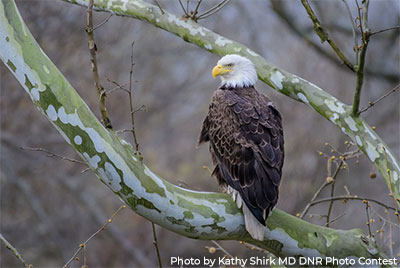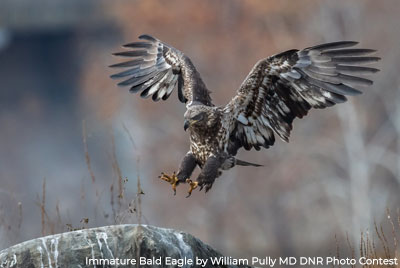Bald Eagle
Haliaeetus leucocephalus

Description & Range:
Bald Eagles are impressive birds that are nearly 3 feet tall and have a
wingspan over 6 feet! Bald Eagles can weigh between 8-15 pounds. Adult Bald
Eagles have yellow talons (feet) and bill while immature eagles have dark bills
and feet. Juveniles can be mistaken for large hawks or vultures. Bald Eagles
also have dark brown bodies. At 5 years of age, the Bald Eagles' tail and head
feathers are white. Females are slightly larger than males.
Bald Eagles are found in Maryland all year round. Most are concentrated along
the Chesapeake Bay and its tributaries. Bald Eagles can also be found throughout
most of the US and Canada.
Habitat:
Bald Eagles often live near water sources such as near lakes, reservoirs,
rivers, marshes and coasts. Bald Eagles nest in large trees, either pines or
hardwoods, usually at the edge of a wooded area. Many nests border active farm
fields or shoreline. Since eagles have such a large wingspan, they cannot fly
through woods easily, so they build nests where there is easy access. Nests are
built from sticks in the upper crotch of trees. The nests can be 4 to 5 feet
wide and more than 3 feet deep.
Diet:
Fish make up a major portion of Bald Eagle diets. However, Bald Eagles are
also opportunistic feeders and will dine on other birds, small mammals, reptiles
and amphibians if available. Bald Eagles will eat both live animals as well as
carrion. Sometimes, Bald Eagles will steal food acquired by other birds.
Reproduction:
In Maryland, Bald Eagles start courting in December. By March, they lay their
clutch of one to three eggs and begin incubating immediately. Since this is
usually the coldest time of the year, nesting eagles should never be disturbed
as they safeguard their eggs against adverse weather. Some eagle roosts in the
area have 100-200 eagles using them. Blackwater National Wildlife Refuge on Maryland's Eastern Shore is one such place; Aberdeen Proving Ground at the head of the Chesapeake Bay is another area where eagles frequently feed along the Susquehanna River below Conowingo Dam.
After hatching in April, young eagles remain in the nest for about 12 weeks.
Both parents help care for the young. The juvenile eagles start to fly in June,
and by August have learned to hunt and fish on their own. Once they leave the
nest, immature Bald Eagles maintain a nomadic lifestyle until they become fully
mature at about 5 years of age.

Sounds:
Bald Eagles, surprisingly, make a series of high-pitched whistling or piping
notes.
Behavior:
Bald Eagles have powerful wings and can often be seen flying or gliding long
distances. Bald Eagles are also capable of swimming but do so infrequently. When
courting, eagles perform a courtship dance that entails both the male and female
locking talons and cartwheeling towards the ground. The pair breaks their talon
lock just in time to avoid crashing into the ground. Bald Eagles often harass
other birds, and sometimes mammals, to steal their food.
Conservation:
Bald Eagles were once labeled as Endangered in Maryland and throughout much
of its range. The drop in Bald Eagle numbers throughout its range was attributed
to the use of the pesticide DDT which made eagle eggs thin and easily breakable.
A ban on the use of DDT has since allowed the birds to make a tremendous
comeback. In August 2007, the Bald Eagle was removed from the Federal Endangered
Species list, and in April 2010, it was removed from Maryland’s list of
threatened and endangered species.
State-funded surveys of Maryland’s Bald Eagle population were discontinued in 2005. However, the Maryland Bird Conservation Partnership is recruiting volunteers to find and report Bald Eagle nests throughout Maryland and the District of Columbia, and to assist with monitoring these nests. To learn more about this program as well as how to volunteer, please visit the following page: https://marylandbirds.org/bald-eagle-nest-monitoring or contact the Volunteer Coordinator at [email protected]
For more information on Bald Eagles, in general, as well
as links to their calls, then check out the Cornell Lab of Ornithology page on Bald Eagles.